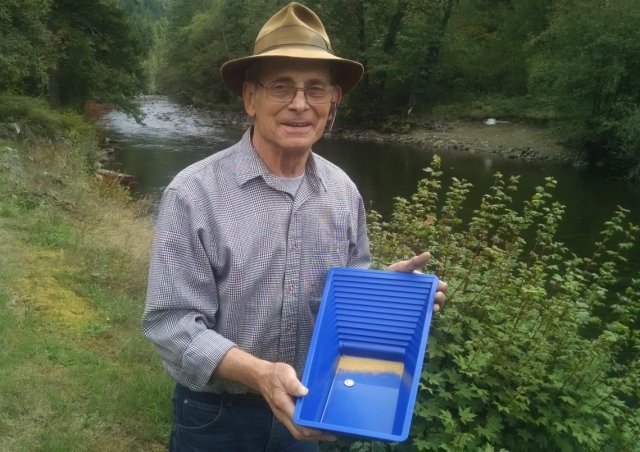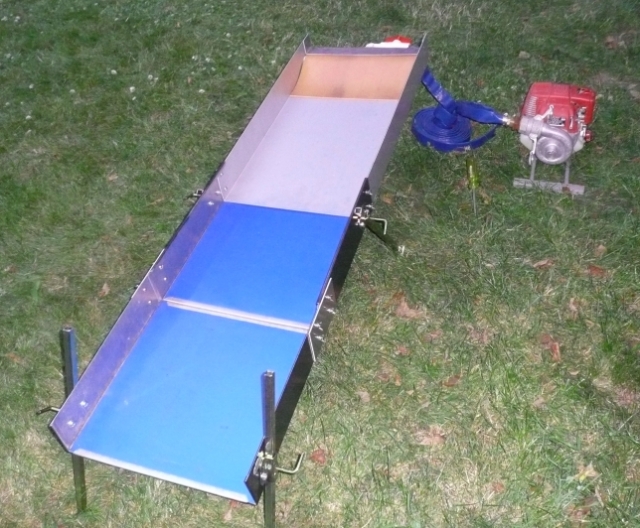
Dennis Katz, using his Maverick Finishing Pan, shows the dust and micro gold that can be captured with the Cleangold System. Some of the particles shown are actually invisible by themselves. The only reason you can see them is because they are clustered together to make what looks like a larger solid object.
It has been quite an experience reaching the level of understanding I now possess. Like most folks, being trapped in “the box” of conventional thinking and technology, it was the drive to find something better, if that was possible, and attempt to do something different to achieve it. From that first Sluice I used on the Arrow River in New Zealand to where I now find myself working in what appears to be the evolution of that technology, I’m now locked in and it appears there is no turning back to the past.
After several lessons with the Inventor of Cleangold running a Beach Box Sluice on the beach, (read Part 4.) I began working with it by myself. At that time here in Washington State, you were not allowed to mine on the beaches so I had to go down to Oregon in order to pursue my interests. In Oregon, also at that time, and even to this day, you are only allowed to Ground Sluice as it is not allowed to use any mechanical or circulation systems on the beaches there. The strange conundrum of this law is that if you are off of the beach line, you can Highbank or do other pursuits not allowed on the beach. So far the only answer I’ve had from any authority on this subject is that they think that anything but Ground Sluicing interferes with tourism there. Go figure! Since this article isn’t an argument with the law, I will not go into what I think of their stand on this issue, but to be fair, I will mention that it is now legal here in Washington State (after a long fight and testing period,) to beach mine on a recreational level with almost any style of equipment though you must have a permit first to do it. (This permit is not difficult to obtain.) The reason I mentioned the stand of law in my area of the North West, is that it had a big effect on my development of the Cleangold product beyond beach use which I handle today.
Over time I did many trips to the ocean testing and getting used to my Cleangold Sluice. This was proving difficult as I live far from the Oregon beaches which was the only place to go then. This problem started me thinking about producing a Cleangold Sluice/Highbanker that could handle just about every environment, be portable and handle 1/4″ on down gravels in regular to very heavy black sand situations. (The Inventor of Cleangold advises and also builds large inland and river systems for large operations worldwide.) Since that element of the Cleangold system is covered, I wanted to focus more on the recreational and small mining operators. It was now time to see what was possible. The first problem that concerned me was that Cleangold works best with very fine and micro gold yet not so well with flake “Surf Board Type Gold.” (Most systems suffer from this shape.) I decided to see if this problem could be addressed and eliminated. Rejecting Riffle Systems, I decided to try various matting’s. Since I had good luck with Raised Rubber Ribbing in the past, plus seeing that it was somewhat popular with the beach sluicing crowd, I installed a large section of it on my new longer Slick Plate and attached this to my now “Slide Together” Cleangold Sluice. I then proceeded to install adjustable legs to address making a Highbanker later. It was now time to test my sluice.
Standing on a cliff overlooking the ocean, I picked up my new Cleangold Sluice and climbed down the path to a popular stream below on the beach. This particular stream ran particular stream ran fairly shallow, but fortunately a Cleangold Sluice can run very well under those conditions with minimal water pressure. Finding a good spot and setting up my sluice there, i found some layers of black sand and shoveled it into the Slick Plate in a timely fashion watching the water carry the sand down the Sluice. As I fed the sand, I could see tiny gold particles showing up in the Raised Rubber Ribbing. With a big smile, I continued to feed my hungry sluice in a timely fashion dropping a black sand slurry from side to side on the Slick Plate. So it went for the rest of the day until the sun was just a dot on the horizon. Taking up and cleaning off my sluice, I could see it was a good day indeed and the new addition of Raised Rubber Ribbing was diffidently a plus addition. It was now time to test the Cleangold Sluice as a Highbanker under river conditions, but first I needed to do a few modifications to my set up.
Designing a new and different Highbanker called for some major changes. The first was to add another piece of Cleangold Sluice to the set up including an extended Slick Plate. To this I added a custom Hopper of my own design, (most Hoppers on the market are stupid at best,) and a 1.5HP motor with a very good pump to drive the Spray Bars with water for the Hopper and Sluice. Now to put it too the test.
Traveling all day, I reached a river in another State away from ocean conditions that I was familiar with. Having been told in advance of a good place on this river to try out, I set up my new experimental Highbanker there and fired it up. Water started flowing from the Spray Bars set on my Hopper then proceeded through a 1/4″ Woven Steel Screen down to a Special Classifier, then to a Secondary Plate which directs the water to the back of the Hopper, then drops around a Curved Rubber Sheet and onto the Slick Plate and down to the sluice. With this configuration the water speed is not broken and the classified gravels will not fall in a clump upon the Slick Plate causing water flow and sorting problems. After several adjustments to the water pressure, level, pitch, etc, I started feeding raw gravel into the Hopper.
Everything worked just as it was made to do and gold capture was very good though I was still losing some of the flat round shapes and barrel types out of the sluice and back to Mother Earth with the tailing. Even though my recovery ratio was satisfactory, this was frustrating as my goal was to get every drop of gold if that was possible to do. There must be an answer – I had to keep looking.
…To be continued.
Cheers,
The Fossicker 2015
_____________________________________
copyright © 2014-2015 Gold Pan Prospector / Fossickers.com










I seriously doubt you’ll ever find a sluice that catches 100%. However there are some good tools out there such as the beach boxes Doug Watson from Washington state sells (see ICMJ for his ads) or, of course, the Gold Cube!
…yes I know you can’t run battery powered equipment everywhere but these are awesome tools.
LikeLike
Howdy Kevininco,
Good to hear from you again. You’re jumping the gun on my next installment, but I will tell you this – the products you mentioned are no match for Cleangold on the beach or perhaps anywhere else and I’ll stand by this. I you’re interested in finding out for yourself, go to my web site for my phone number and give me a call. Cheers.
LikeLike